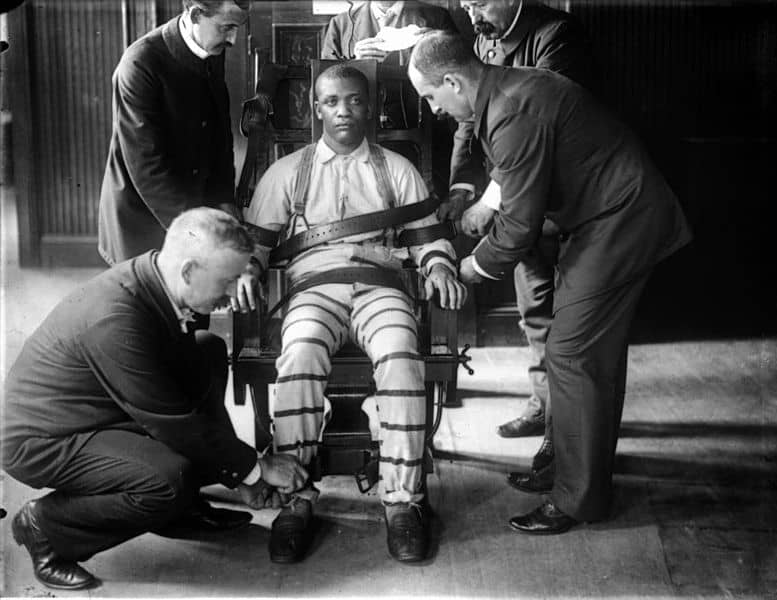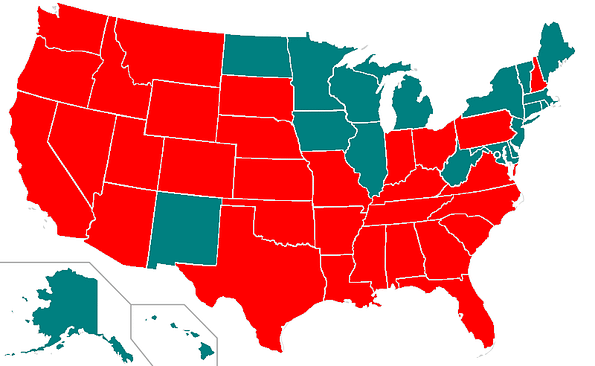Featured Image CC by George Eastman
In the 1800’s, hanging was the most common form of execution. George Painter was a well-educated man who lived with his girlfriend Alice, in Chicago, Illinois. Painter was accused by neighbors of abusing his wife, but it was never stopped. Although he was educated, he had a bad reputation. He spent lots of time drinking and gambling and spending his girlfriend’s money. The neighbors reported loud sounds coming from the apartment the night of Alice’s death. Soon after, Painter rushed out to get the police. He was claiming he was innocent, but the police called his bluff and arrested him, noticing blood on his coat.
Painter was sentenced to death by hanging for the death of his girlfriend. Although Painter still claimed he was innocent, not much investigation was put into the case after the blood was found on him.
During the execution, two ropes were tied around Painter’s thighs, and a hood placed over his head. When the noose was around his neck and he had said his last words, the ropes were cut, and Painter plummeted down. Instead of killing him, the rope went tight and snapped, sending Painter to the ground. Doctors established that although his neck had broken, he was still alive. When the rope was taken from around his neck, the blood quickly turned his white robe and hood red. The execution was reset, this time killing Painter.
Innocence
In the last semi-century, 144 people have been excused from death penalties. That’s just over 1.5% of all the death penalties. Unfortunately, the rate of innocence is over double that, coming in above 4%. These stats prove shocking results: Many people have been killed for crimes they didn’t do.
Ledell Lee, a man from Arkansas, was executed on April 20th, 2017 for the murder of his neighbor in 1993. Up until he was killed, he claimed his innocence. He called for DNA tests, none of the results pointing to him. Witnesses from the crime scene had claimed there was blood everywhere, but none appeared on Lee. Against all evidence, he was executed anyway.
The world may never know if he was truly innocent or not, but many factors were not considered.
Behind the scenes, the judge was having an affair with a prosecutor, there was a white jury, who was said to have been racist, and an extremely drunk appeals attorney. Overall, Ledell Lee never had a chance.
In another case, a man named Carlos DeLuna was sentenced to death and executed in the year 1989 for stabbing a gas clerk to death. DeLuna claimed he was innocent to the end. After he was killed, a report was published proving his innocence.
These examples show that even if the death penalty is not abolished, it should be a further investigated process then it has been and is to this day.
An American author, Edward Abbey, once said, “The death penalty would be even more effective, as a deterrent, if we executed a few innocent people more often”. Edward Abbey had many valid points throughout his life, but this was not one of them. The more innocent people that are executed, the less credible the death penalty will become.
Merriam-Webster defines the word innocent, “Free from guilt or sin especially through lack of knowledge of evil”.
How is it possible that people this word describes, have been killed? The death penalty should be considered murder, especially in cases like this.
[perfectpullquote align=”full” bordertop=”false” cite=”” link=”” color=”” class=”” size=””]Unfortunately, the rate of innocence is over double that, coming in above 4%. [/perfectpullquote]
A Step in the Right Direction
Norman Mailer, a novelist, and Holly Near, a singer-songwriter, have both asked the question, “Why do we kill people who are killing people to show that killing is wrong?” It’s a valid question and one that needs answering. If the executioners were given the same punishment as the criminals for their murders, it would be a never-ending cycle. The American Civil Liberties Union states, “[W]e believe that the state should not give itself the right to kill human beings.”
So far, only 19 states have abolished the death penalty. Michigan, the first state to remove it, did so in 1846. A couple states followed their example, but 31 states are still to this day stuck in the mindset that killing people is okay. Texas remains in the number one spot in execution numbers, ending over 543 lives since 1976. Virginia comes in second, with 113. These numbers show that not only are a lot of lives being taken but also that Texas especially is a huge problem in the death penalty debate. What makes their immense use of the death penalty even more confusing, is that Texas isn’t even in the top 10 list of states with the most crimes.
The Cruelest of Cruel and Unusual Punishments
There have been many instances where something went wrong during the execution, even for lethal injection, which is most often used to this day. Firing Squad is the only method with a 0% botched rate.
In 2014, Clayton Lockett’s execution by lethal injection was botched when a new mix of chemicals was not tested before being used on Lockett. While the chemicals were flowing through his veins, Lockett suffered a heart attack. He was deemed unconscious, but groaned, spoke, and even tried to get up, showing that was false. The execution was stopped, but Clayton Lockett died anyway, 45 minutes after being given the chemicals.
John Louis Evans, half of a well-known criminal duo, committed over forty crimes while on parole with his partner, Wayne Ritter. Included in those many incidents were robberies, kidnappings, and extortion schemes. Eventually, these crimes turned deadly when the pair killed a pawn shop owner in the midst of a robbery. After only fifteen minutes in court for the murder, Evans was sentenced to be put to death by electric chair.
Evans was put to death on April 22, 1983, in Yellow Mama, an electric chair built by a convict six decades before, and had not been used in over two. 1,900 volts of electricity circulated through Evans’ body for 30 seconds. The average execution by electric chair lasts 2-15 minutes. Around the 30 second mark, Evans’ body caught on fire, began smoking, and rapidly slammed against the chair as he clenched his fists. When checked by doctors, it was shown Evans still had a heartbeat. He was shocked again, after being denied a clemency request for cruel and unusual punishment. The third shock worked and ended the life of John Louis Evans. The death penalty requires much more thought than is usually put into it. It’s an extreme punishment and should only be used in the most extreme cases. The court, however, tends to not think it through or consider the consequences.
So What Should We Do Instead?
There are many matters wrong with the death penalty that gives it the need to be completely abolished.
On average, the court spends less than three months to decide on execution as a punishment. Someone’s life should be worth more than 3 months of consideration. Taking a life is a very serious matter, and should be treated as such. Every angle should be covered, and consequences should be considered.
Due to the quickness of the decision, many innocent people are executed. People who have not done anything wrong still paid for a crime with their life. The mistake happens often enough that the use of the death penalty should be seriously reconsidered.
The death penalty is a very severe punishment, and should only be used for the most major crimes, if at all. When people are executed for a murder, the executioner is just as bad as the person they’re killing. We punish some for murder but not others, simply based on their rank. It’s discriminatory against certain people, does not solve any problems, and isn’t getting our country anywhere in crime rates. It is an unnecessary punishment, that is much worse than many realize.
Overall, the death penalty is the easy way out. In most cases, the execution is done in minimal time. Forcing criminals to spend their lives in jail with no opportunity for parole. Prison is not somewhere anyone wants to go. Although you are fed and clothed, life for prisoners is awful. You don’t have any control over your life, cells are small and uncomfortable, and obviously the other criminals there aren’t exactly nice. Depending on the person, they may also develop the feeling of guilt or grief over what they did, while if killed, will never have to.
Prison life has been described in many different ways, none of them good. If we really want to punish criminals and prevent ourselves from becoming killers as well, life sentences without parole should replace the death penalty.
[embedyt] https://www.youtube.com/watch?v=SZcc9E4_7Bw[/embedyt]








Adam
I really appreciate the insight you provided on the conviction of innocent people on death row, as it was very eye-opening to me. However, I was confused/wanted clarification on your last point/paragraph. If prisoners are going to be in prison for the rest of their life with no opportunity for parole, how is that a better option? To try and make them realize that what they did was wrong? Is it assumed that the criminal will repent? Bottom line, does it make a difference whether they changed their ways if they have no opportunity for parole? In 2012, it costed on average about $168,000 for one inmate to be housed, fed, and guarded each year in New York City. Assuming the convict with life in prison will be there about 40 years (just an estimate, could be higher or lower), it will cost a total of $6,720,000. The question we need to ask ourselves is if this sum is truly worth it.
(source on the cost for an inmate)
http://www.nytimes.com/2013/08/24/nyregion/citys-annual-cost-per-inmate-is-nearly-168000-study-says.html?mtrref=www.google.com&gwh=3D233067D5B1E40F9055B9DA9461DFF2&gwt=pay
Isabella
I did a project on this topic in 7th grade.
Megan
I read your post, and I agree with you 100%.
Joey
I really enjoyed your topic, I totally agree with you, and I learned a ton. Thank you very much for sharing your viewpoint.